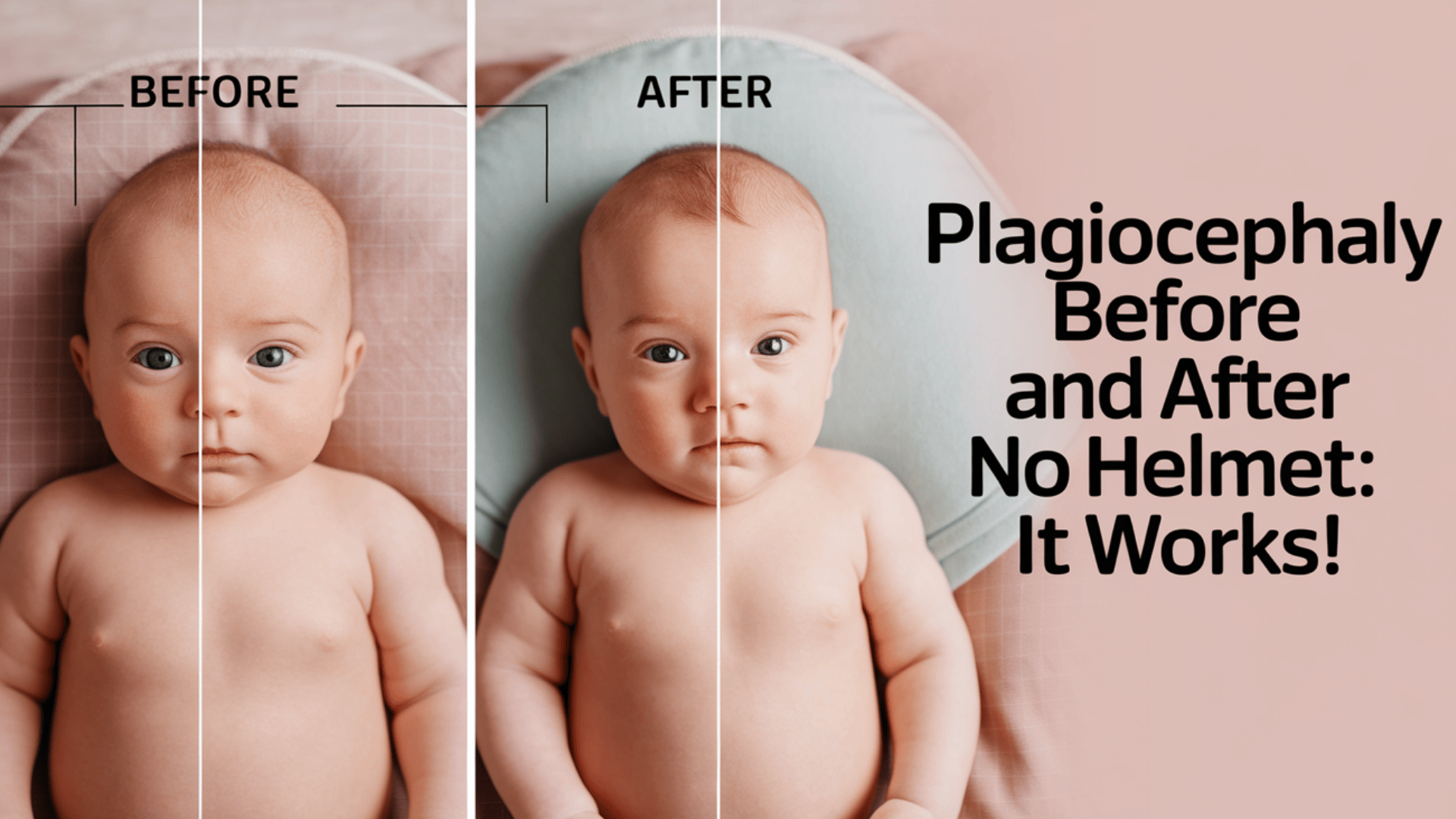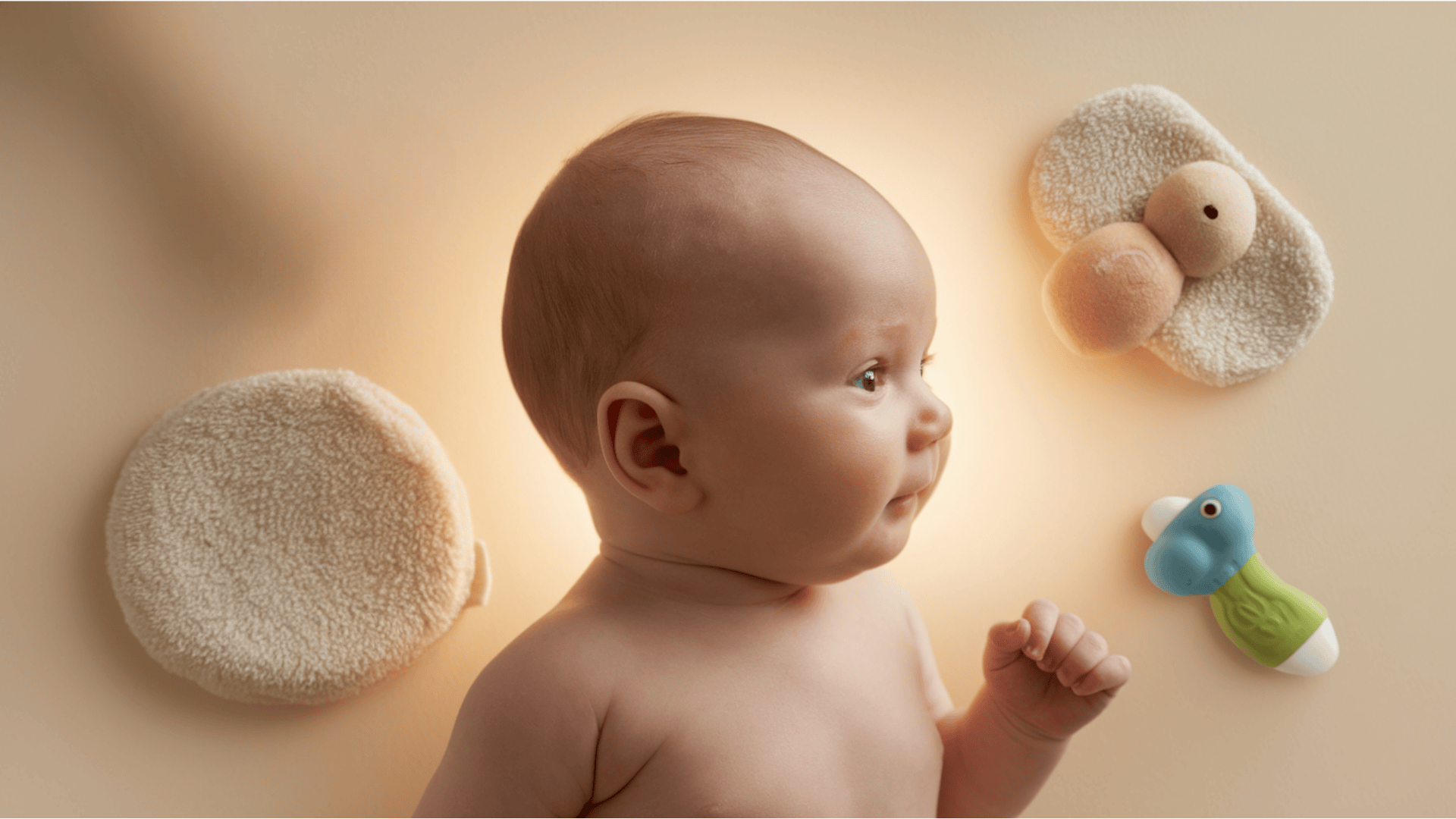
Is your baby’s head flat on one side? You’re not alone. Plagiocephaly affects 1 in 5 babies, causing a noticeable flat spot that can worry parents.
While expensive helmets are often presented as the solution, many families successfully correct their baby’s head shape naturally.
Through simple repositioning techniques, regular tummy time, and understanding your baby’s development timeline, you can help your little one achieve remarkable improvement without helmet therapy.
Studies show that over 70% of mild to moderate cases show significant improvement with positioning therapy alone.
Learn how to effectively reshape your baby’s head using proven natural methods that benefit their overall development, too.
What is Plagiocephaly?
Plagiocephaly (play-jee-oh-sef-uh-lee) is the medical term for flat head syndrome. It happens when a baby’s soft skull develops a flat spot, usually on the back or side of the head. This flattening can occur when babies spend too much time lying in the same position.
The good news is that plagiocephaly doesn’t affect brain development and is usually just a cosmetic issue. Most cases can be prevented or treated without surgery.
Prevention includes regular “tummy time” when your baby is awake, changing your baby’s head position during sleep, and limiting time in car seats and swings.
If you notice a flat spot on your baby’s head, talk to your doctor. Treatment may include repositioning techniques, physical therapy, or sometimes a special helmet.
Types of Plagiocephaly
There are actually different types of flat head syndrome that parents should be aware of:
- Positional Plagiocephaly: The most common type, caused by pressure on one part of the skull. This typically appears as a flattening on one side of the back of the head.
- Brachycephaly: When the back of the head becomes flattened, making the head appear wider than it is long. This happens when babies spend too much time lying on their backs.
- Scaphocephaly: An elongated head shape that can occur when babies spend too much time with their heads turned to the side.
Why Consider Non-Helmet Options?

When parents first notice their baby’s flat spot, they often worry about whether they’ll need a helmet. But before jumping to helmet therapy, there are many good reasons to try natural correction methods first.
1. Cost Considerations
Helmet therapy typically costs between $1,500 and $4,000, depending on the provider and region. Many insurance companies consider it cosmetic unless there’s a severe deformity.
This financial burden can be significant for families already managing the many expenses of having a new baby.
2. Natural Development Advantages
A baby’s skull naturally reshapes itself as it grows and develops. By using positioning techniques and exercises, you’re not just fixing the flat spot—you’re also helping your baby develop stronger muscles and better motor skills.
These natural approaches offer developmental benefits beyond just head shape correction.
3. Success Rates
Research shows that natural correction methods can be remarkably effective for mild to moderate cases. One study found that over 70% of babies with mild plagiocephaly showed significant improvement with repositioning therapy alone.
One mom told us: “We were worried about our daughter’s flat spot, but our pediatrician suggested trying repositioning first. After three months of consistent effort, we saw amazing improvement—without a helmet!”
4. Avoiding Potential Drawbacks
While helmets are generally safe, some parents worry about the potential impacts on bonding and sensory experiences.
Babies learn through touch and feel, including feeling their head. Natural methods allow for unrestricted tactile experiences and make cuddling, kissing, and skin-to-skin contact easier.
Effective Ways to Fix a Flat Head Naturally

1. Repositioning Techniques
Changing how your baby lies is one of the best ways to help their head round out naturally.
During sleep, if the flat spot is on the right side, place your baby so they have to turn left to see the room or you, and switch sides regularly.
While feeding, alternate the arm you hold your baby in during bottle feeds, or try different holding positions for breastfeeding. During play, place toys on the non-flat side to encourage your baby to turn that way.
PRO TIP: Make a simple chart on your phone or fridge to track which side your baby’s head is positioned each time you put them down. This helps ensure you’re varying positions throughout the day.
2. Tummy Time: Your Secret Weapon
Tummy time isn’t just for muscle development—it also relieves pressure on the back of your baby’s head!
Start with 1-2 minutes several times a day and work up to longer periods as your baby gets stronger. Always supervise tummy time.
Try these ideas to make tummy time more fun: Get down on your baby’s level and make funny faces. Use colorful toys or mirrors to catch their attention.
For a gentler experience, put the baby on your chest while you recline. Try adding tummy time after diaper changes when your baby is already on its back.
3. Physical Therapy Exercises
Sometimes, babies develop tight neck muscles that make them favor turning to one side. This is called torticollis. Simple exercises can help:
Try gentle neck stretches by carefully turning your baby’s head to each side during diaper changes. With your supervision, help your baby spend time lying on the non-flat side. Increase upright time by carrying your baby vertically or using a baby carrier to keep pressure off the flat spot.
If your baby strongly resists turning their head in one direction, talk to your doctor about a physical therapy referral.
4. Changing Baby’s Environment
Smart changes to where your baby spends time can make a big difference:
Change which end of the crib your baby’s feet point toward each week to encourage different head positions. Use the car seat only for travel rather than as a general baby holder. Limit time in any one position by mixing up time in swings, carriers, play mats, and being held.
PRO TIP: Babies should always sleep on their backs for safety, but you can still vary which direction they face. Try placing a mobile or interesting picture on the wall to draw their attention to the non-flat side.
Plagiocephaly Before and After

Every baby’s ride to improved head shape follows a different timeline, but there are common patterns parents can expect. Understanding these milestones helps set realistic expectations and keeps you motivated through the process. Here’s what typically happens when using natural correction methods at different stages.
| AGE RANGE | HEAD SHAPE IMPROVEMENT | MOBILITY & POSITIONING MILESTONE |
PARENTAL NOTES & ENCOURAGEMENT |
|---|---|---|---|
| First Month | Early shaping begins, but no major visual changes yet. | The baby starts turning to the non-preferred side with gentle support. | Be consistent with routines and take weekly photos to track progress. |
| Three Months | Flat areas may round out; slight ear alignment improves. | Head control strengthens during tummy time and upright holding. | Progress becomes visible with regular tummy time and upright positioning. |
| Six Months | The head shape shows noticeable improvement. | Sitting and early crawling reduce head pressure. | Movement helps reshape naturally; repositioning becomes less needed. |
| Nine–Twelve Months | Final adjustments occur; the head shape nears its natural outcome. | The baby crawls, stands, or walks as the skull hardens. | Results stabilize by one year; dramatic changes slow down. |
What Affects Success with Natural Correction?

Several key factors influence how well natural correction methods work for plagiocephaly. The severity of flattening, your baby’s age when starting treatment, and consistent repositioning all play crucial roles in success.
Younger babies (under 4 months) with mild to moderate cases respond best.
Regular position changes throughout the day significantly improve outcomes. Depending on their unique situations, some babies may need more time or additional interventions.
1. Severity Matters
Natural methods work best for mild to moderate cases. How can you tell the difference? Mild cases show slight flattening that’s hard to notice when looking at your baby from the front. Moderate cases have clear flattening visible from multiple angles, possibly with some ear misalignment. Severe cases show significant flattening with facial asymmetry or more pronounced ear misalignment.
If your baby has severe plagiocephaly, your doctor might recommend helmet therapy.
2. Age is Key
The younger your baby is when you start, the better. Babies under 4 months often respond best to natural correction. Their skulls are most moldable during this time. They also haven’t developed strong position preferences yet. Plus, there’s more rapid brain growth, creating natural pressure from inside that helps reshape the skull.
3. Consistency Counts
Parents who diligently reposition their baby throughout the day see better results. One study found that babies whose parents repositioned them at least 5-7 times daily showed twice the improvement of those repositioned less often.
PRO TIP: Set a gentle alarm on your phone every 2-3 hours as a reminder to check and possibly change your baby’s position during waking hours.
4. Other Factors
Some babies may have other things affecting their progress:
- Premature babies may need more time
- Babies with tight neck muscles might need physical therapy
- Some babies naturally prefer one position very strongly
When to Visit a Pediaterican

If you notice your baby’s head looks flat on one side (plagiocephaly), don’t panic. Most cases can be improved without a helmet through simple repositioning techniques. However, you should visit your pediatrician if:
- The flatness doesn’t improve by 4 months of age
- Your baby strongly prefers turning their head to one side only
- You notice facial asymmetry (uneven features)
- The flat spot seems severe or is getting worse
- Your baby has trouble moving their neck in all directions
Your doctor can assess if the condition needs monitoring or if other treatments might help. Early evaluation gives your baby the best chance for normal head shape development.
Final Thoughts
Natural correction for plagiocephaly saves thousands of dollars and supports your baby’s overall development.
By implementing consistent repositioning, prioritizing tummy time, and understanding the natural timeline for improvement, most families see significant results within 3-6 months.
The younger you start, the better the outcome, with babies under 4 months responding best to these approaches.
While severe cases may still require professional intervention, pediatricians confirm that 70% of mild to moderate flat spots improve significantly without helmets.
As your baby grows more mobile and their hair thickens, any minor remaining asymmetry typically becomes virtually unnoticeable. Nature’s approach works—and it benefits the whole family.
If you’re interested in more informational content on mothers and babies, feel free to click here and research other blogs that you might enjoy.
